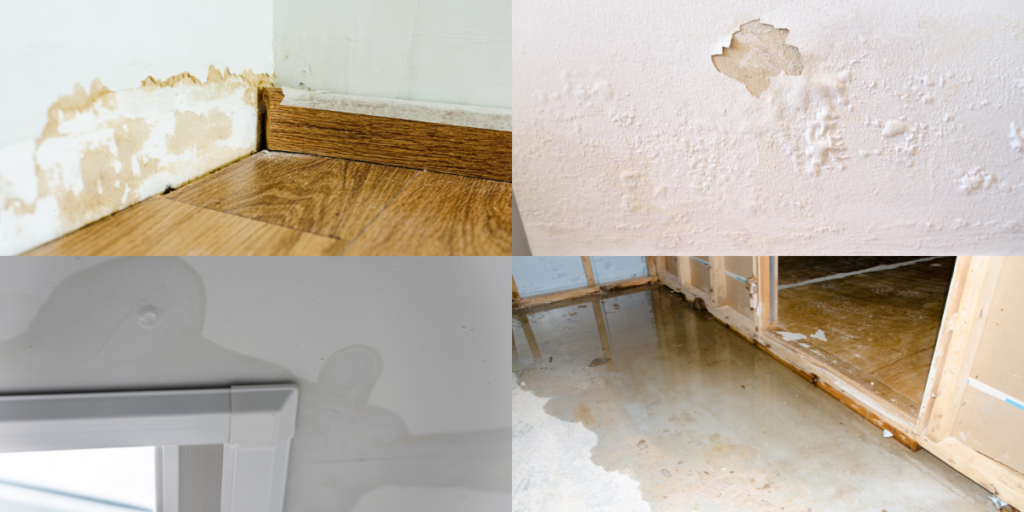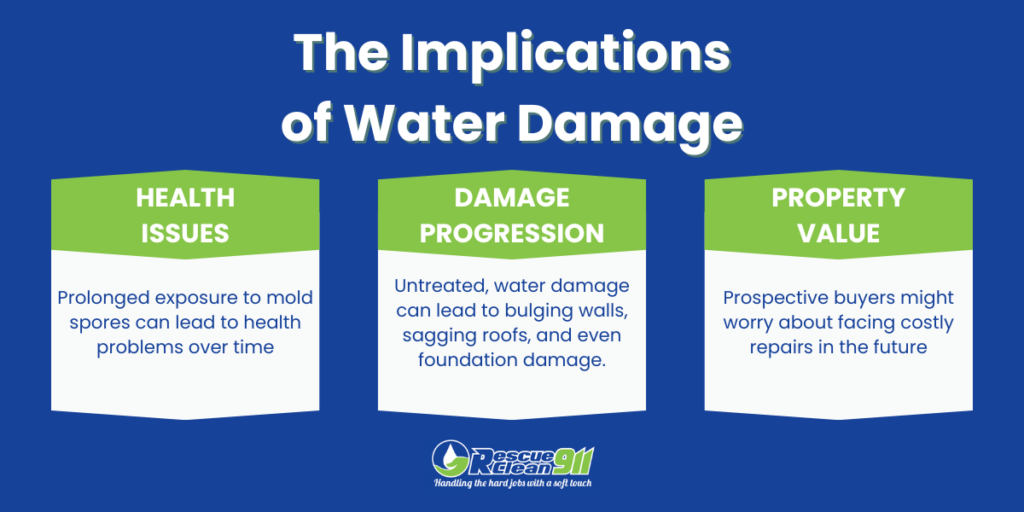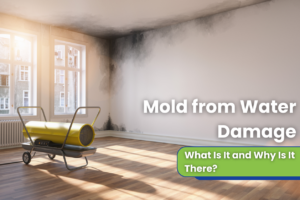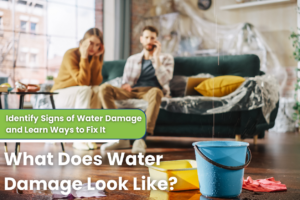Typically, you'll encounter visible cues like water spots, discolorations, and soft spots on various surfaces. You may also notice a distinctive honeycomb pattern in wooden structures, a potential dual indicator of water and termite damage. Along with these signs, you may smell a musty odor, suggesting mold growth.
Guide
Water damage can quickly escalate from a minor issue to a nightmare, and the initial signs can easily be overlooked. Without prompt attention, these issues can spiral into major repairs and significant expenses. So, how can you spot water damage in its early stages?
Typically, you’ll encounter visible cues like water spots, discolorations, and soft spots on various surfaces. You may also notice a distinctive honeycomb pattern in wooden structures, a potential dual indicator of water and termite damage. Along with these signs, you may smell a musty odor, suggesting mold growth. In more severe cases, you might even find significant structural changes in your home.
Identifying Signs and Warnings of Water Damage
Staying informed about these indicators is crucial for timely intervention, which can significantly mitigate damage and reduce the costs associated with extensive repairs. Here’s what to watch for:
Visible Damage
Common indicators are water spots or discolorations on walls, ceilings, or floors. You might also see peeling paint or wallpaper, or a honeycomb pattern in wooden structures, which could signify both water and termite damage.
Unpleasant Odors
A distinct, musty smell when entering a room can mean water damage. This odor usually points to the presence of mildew or mold, which thrives in moist environments caused by leaks or prolonged water exposure.
Structural Changes
Water damage can also affect the integrity of your home. Look for soft spots on floors, swollen wooden elements, and damp or sagging drywall—these are signs of significant water issues.
Mold Spores
Visible mold spores mean prolonged water damage. Mold, including harmful black mold, can develop in just 24 to 48 hours under the right conditions. This is particularly common in damp areas with ongoing moisture problems, such as from leaking pipes, and poses a serious health risk.
Recognizing these signs early is key to preventing more severe damage. Regular checks and maintenance can help you catch these issues before they escalate. If you suspect water damage, consider consulting a professional to assess the situation and take appropriate actions to safeguard your home.

Common Causes of Water Damage
Leaks are among the most common culprits causing water damage. The list includes:
Burst Pipes
A burst pipe can cause substantial water damage depending on the size of the pipe and length of time it takes to close the water supply. A small fracture in your piping system can turn a drip into a flow of water, gradually wreaking havoc in your home.
Leaky Pipes
Leaky pipes may seem minor, but over time, they can lead to severe water damage. The leak usually originates from pipe joints and causes gradual deterioration of walls, ceilings, and floors.
Leaky Roofs
If your roof isn’t in optimal condition, water can find its way into your home. Roof leaks usually lead to ceiling water stains, mold, or even structural damage if not addressed promptly. Missing shingles and poor roof drainage are common roof leak causes.
Water Leaks
Water leaks can come from a variety of sources. For instance, sometimes water heaters could be the source. Your water lines should be frequently checked for leaks to avoid water damage.
Natural Disasters, like hurricanes and floods, can also lead to significant water damage. The resulting water intrusion might demand extensive salvage measures.
Understanding the Implications
Damage Progression
If left unchecked, water damage can worsen. Thousands of homeowners in the United States alone deal with the repercussions of untreated water damage every year. What may start as a simple leak from a leaky roof or pipe can extend to compromising the structure of your property, leading to bulging walls, sagging roofs, and even foundation damage.
Health issues
Those musty smells are more than just unpleasant odors; they equate to mold growth. Mold spores are a common indoor air pollutant. Prolonged exposure to these spores can lead to health problems over time, including allergies, respiratory issues, and in severe cases, toxic mold syndrome.
Property Value
If you’re thinking of selling your home or property, untreated water damage can significantly lower its value. Prospective buyers are wary of properties with visible damage, signs of mold, and structural issues – all common consequences of water damage. They might worry about the likelihood of facing costly repairs in the future.
While these scenarios sound dire, they’re also avoidable. The key to preventing widespread water damage is early detection and swift action. The sooner you start addressing the issue, the better your chances are of reducing further damage and associated costs.

How to Fix Water Damage
Water damage in your home can range from small to disastrous, but knowing how to address it can help you avoid harm and restore your space. Here’s how to tackle water damage, from DIY methods to when it’s time to call in the professionals.
DIY Methods
For minor water damage, there are several DIY approaches you can take to manage the situation:
- Using a Blow Dryer: A blow dryer can be used to dry out water-damaged spots, particularly on wood and drywall. Keep the dryer moving over the damp area to evenly distribute heat and prevent further damage to the material.
- Repair Techniques: Small holes in drywall can be patched using spackle or joint compound. Apply the compound, allow it to dry, then sand it down for a smooth finish.
- Dealing with Water Stains: For ceilings and walls, water stains can be covered with a stain-blocking primer and repaint. Ensure the area is completely dry before painting to prevent mold growth.
Professional Assistance
In cases of significant water damage, professional help is necessary:
- Importance of Serial Number: For appliances or equipment damaged by water, have the serial number handy when you call for repairs. This information expedites the service and ensures you get the correct parts for your model.
- When to Call a Claim Adjuster: If the damage is extensive, involving structural issues or a large area, it’s prudent to contact your insurance company. A claim adjuster can assess the damage and determine if your policy covers the repairs needed.
- Water Damage Restoration: Professional water damage restoration services can effectively handle severe issues like flooding, large leaks, and situations where mold has developed.
Precautionary Measures
Addressing issues early can prevent significant damage. By understanding how to address water damage effectively, whether through DIY methods or professional help, you can protect your home and maintain its integrity. To prevent future water damage, consider these preventive steps:
- Weatherproofing: Seal windows and doors, and ensure your home’s exterior is well-maintained to prevent water ingress.
- Updated Homeowner’s Insurance: Regularly review and update your insurance policy to cover potential water damage, considering your area’s risk factors.
- Routine Inspection: Regularly inspect your property for signs of leaks, especially in prone areas like the bathroom and kitchen.
If the damage seems beyond your ability to manage, do not hesitate to seek professional assistance to ensure thorough and safe restoration.
How Rescue Clean 911 Can Help
Water damage, if not properly mitigated, can lead to long-term issues, including structural damage and mold growth, which pose serious health risks. Rescue Clean 911 specializes in addressing these critical situations with expertise and efficiency in South Florida. Our team of professionals is equipped with the latest tools and technology to ensure comprehensive cleanup and restoration of your property.
For any water damage emergency, whether big or small, don’t hesitate to contact Rescue Clean 911. Acting quickly can save your property from further damage and potentially high repair costs. Trust our experienced professionals to bring your home or business back to its pre-damage condition safely and effectively.
Call Rescue Clean 911 today for reliable and prompt water damage restoration services. We’re here to help restore safety, comfort, and peace of mind when you need it most!










